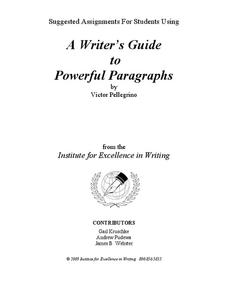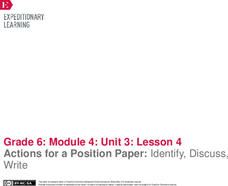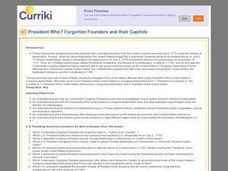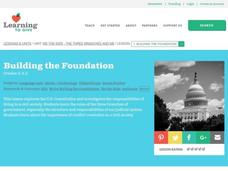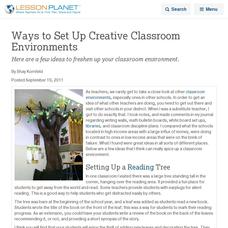US Institute of Peace
Characteristics of Peacebuilders
Can anyone become a peacebuilder? A lesson on character education challenges scholars to examine the characteristics of well-known peacebuilders. Pupils then look within themselves to discover their own strengths as they relate to...
Institute for Excellence in Writing
A Writer’s Guide to Powerful Paragraphs
When it comes to teaching writing, it helps to start small. A supplementary guide to A Writer's Guide to Powerful Paragraphs provides suggested activities to help writers craft a variety of paragraphs. Each assignment covers a...
Scholastic
Lesson 3: Essay Organizer
A three-minute exercise warms-up scholars' writing abilities in order to follow a writing process that ends in an essay. The essay's topic is a barrier and the values used to break it. Four steps include choosing a topic,...
EngageNY
End of Unit 3 Assessment: Writing a Research Synthesis
Ready, set, write! Scholars work on the end-of-unit assessment by completing a writing prompt. They then look at the model performance task from instructional activity two to create a rubric for scoring the exercise. Using turn and talk,...
EngageNY
Mid-Unit Assessment: Completing My Draft Position Paper
What's the difference? Scholars analyze the similarities and differences between introductory and concluding paragraphs. Then, using a model essay as a guide, they write their draft position papers.
EngageNY
Actions for a Position Paper: Identify, Discuss, Write
Anchors aweigh, it's time to write! After viewing an anchor chart detailing the parts of a position paper, pupils share their plans for their essays with a partner. Next, they write the rough draft of their body paragraphs.
Curated OER
Comprehending Through Questioning
Elementary schoolers observe and apply a variety of reading comprehension strategies. They silently read a passage out of their science textbook, and discuss answering the who, what, where, when, and how of the text. In small groups they...
Curated OER
Reading Examples
Young writers read excerpts from Gary Paulsen's memoir to identify figurative and literal language that contain sensory details. They determine which selections are examples of sensory language and fi the language is used literally or...
Curated OER
The 5 W's of Reading
Primary students will use the five "W" questions for reading comprehension as they read silently to themselves so that they can understand and remember what they have read. They then read The Velveteen Rabbit aloud, discussing the five...
Curated OER
Plot of a Short Story (SMART Board)
Help your pupils track the plot of a short story with this SMART Board activity. Using the short story "The Dinner Party" by Mona Gardner (though the lesson would work with any other short story), they define the exposition, rising...
Curated OER
Expressive Eloquent Experts
What does it mean to read expressively? Beginning readers hear examples of expressive reading and partner up to practice. One partner reads The Littlest Pumpkin and the other partner reads Franklin and his Friend. While...
Curated OER
Understanding Poetry
Students search the Internet to find a poem to research, analyze and present their interpretation of the poem to the class. They develop their interpretation in Microsoft Word and PowerPoint.
Curated OER
Hop on the Express Train to Read Expressively
Encourage beginning readers to read expressively. After the teacher models what it's like to read with expression, pairs of learners work together to practice developing this ability. While one learner reads, the other marks a check-list...
Curated OER
I'm Done! What Now?
You can use these lesson plans to give your high ability math students something challenging to do when they finish early!
Curated OER
President Who? Forgotten Founders and Their Capitols
Students explore the beginning of the United Colonies that were formed in 1774. In this history lesson, students discuss the Articles of Confederation and then answer questions about the events surrounding the development of the...
Curated OER
Explore Writing with Louis Sachar
Students identify and interpret the author's writing process and how he came up with his idea for Holes. They experience a moderated chat with the author by participating or reading the transcript. Students also reflect on their own...
Curated OER
Building the Foundation
Students understand the purpose of the judicial branch of government. In this judiciary lesson, students participate in exercises to understand how the court system works. Students complete activity sheets to develop understanding of...
Curated OER
Ways to Set Up Creative Classroom Environments
Here are a few ideas to freshen up your classroom environment.
Curated OER
Equations Lesson Plan
Seventh graders play "What's my Rule" beginning with simple equations and working towards harder problems as student's gain confidence. They evaluate the equations by graphing them. Students identify the slope and y intercepts of the...
Curated OER
Geometry Center Games
First graders explore eight geometry activities that improve understanding of positional words and shapes. They identify, describe, and create simple geometric figures. They help another student who may not understand the concept yet.
Curated OER
Something's Fishy!
Students experience center activities to explore the habits and traits of fish. They observe a goldfish, play a memory game, complete artwork and read about fish.
Curated OER
Atomic Structure and Bonding
Eighth graders discuss and write about what led up to the discovery of the atom. Students label proton, nucleus, electron, and neutron in their notes. Students take notes on electron shells and how different atoms have different...
Curated OER
Punnett Squares
Eighth graders take a short quiz on genotypes and phenotypes. As a class, they are introduced to the concept of Punnett Squares and listen to a description of Gregor Mendel's pea experiment. In groups, they complete Punnett Squares to...
Curated OER
Charles Darwin
Students research Charles Darwin and the process he used to develop his theory of evolution. They keep a journal about the skill of observation and make a newspaper of their learning.



